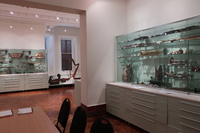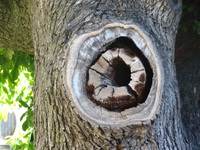Items
Site
The Medicine Chest
keywords is exactly
Edmund February
-

Healing instruments
“I invited Edmund February to the Kirby collection to view the instruments and learn his thoughts on them from a botanical perspective. February identified the dancing rattles as being made of the seed pods of Oncoba spinosa (Venda: mutuzwa) and the seed pod of Adansonia digitata (Venda: muvhuyu). The wood of the iodophone was, however, unrecognisable as a result of its handling. February also contacted colleagues in the Department of Zoology and the School of Mathematical & Natural Sciences at the University of Venda, who connected me to a Venda diviner, Muanalo Dyer, who uses similar baobab rattles (and other materials from that tree) in her healing practices. This interdisciplinary engagement showed that these instruments, supposedly frozen in their early 20th century understanding of being on the brink of extinction, remained very much functional in the present” (Liebenberg 2021: 271). -

The Kirby collection of musical instruments
"Kirby’s choice of an ‘age-old simple classification’ to order the instruments can be correlated with another classification formulated at Wits around the time he was collecting. The Department of Bantu Studies was established in the 1920s at roughly the same time as the Music Department. Kirby’s use of the phrase ‘native races’, which features in the title of his book, resonates with the descriptive subtitle of the Wits journal connected to research in this department: Bantu Studies: A Journal Devoted to the Scientific Study of Bantu, Hottentot, and Bushman (Nixon 2013: xii). The homogenising act of categorising all diverse indigenous South African groups into three general categories seems to echo Kirby’s taxonomic imposition on the diverse instruments he collected on his trips and that continues to feature as the ordering principle of this collection" (Liebenberg 2021: 136). -

Rattles in the Kirby collection
A drawer of rattles in the South African College of Music's Kirby collection: "The instruments are now grouped in different cabinets according to the taxonomy set out by Kirby in his book. In the preface to the second edition (1964), Kirby shares some of his considerations when deciding how to group the instruments, writing that he had to decide ‘whether to arrange his material tribally, or to deal with each type of musical instrument separately from the technological and historical points of view, allowing the tribal aspects to emerge incidentally’ (Kirby 1964: xi). Kirby chose the second alternative, stating that his chief reason was that he wanted the work to be, as far as possible, ‘a complete and comparative study of one particular aspect of the life of our aborigines’ (1964: xi). His second consideration was to find the most suitable manner for classifying the instruments, for which he defaulted to the ‘age-old simple classification of musical instruments into three main groups of percussion, wind and strings’ (1964: xi) – a Western system for the classification of instruments and the principles on which they were based. The chapters in his book and the displays in the room are thus grouped into three categories: percussion – ‘rattles and clappers’, ‘drums’, ‘xylophones and sansas’ and ‘bull-roarers and spinning-disks’; wind instruments – ‘horns and trumpets’, ‘whistles, flutes, and vibrating reeds’ and ‘reed flute ensembles’; and stringed instruments – ‘stringed instruments’ and ‘Bushmen and Hottentot violins and the ramkie’. Kirby encountered one taxonomic anomaly when employing this system: the ‘gora’, an instrument both wind and string, which he termed ‘a stringed-wind instrument’" (Liebenberg 2021: 135). -

The Tralfamadorians
In Kurt Vonnegut's 'Slaughterhouse-Five', the protagonist Billy, is abducted by aliens and taken to their planet, Tralfamadore. Throughout the novel, Billy imparts what he has learned from the Tralfamadorians, whilst there. In one instance, in a letter to a late night radio station, he writes about their views on time: "The most important thing I learned on Tralfamadore was that when a person dies he only appears to die. He is still very much alive in the past, so it is very silly for people to cry at his funeral. All moments, past, present, and future, always have existed, always will exist. The Tralfamadorians can look at all the different moments just the way we can look at a stretch of the Rocky Mountains, for instance. They can see how permanent all the moments are, and they can look at any moment that interests them. It is just an illusion we have here on Earth that one moment follows another one, like beads in a string, and that once a moment is gone it is gone forever. When a Tralfamadorian sees a corpse, all he thinks is that the dead person is in a bad condition in that particular moment, but that the same person is just fine in plenty of other moments. Now, when I myself hear that someone is dead, I simply shrug and say what the Tralfamadorians say about dead people, which is 'So it goes' " (Vonnegut 1969: 24 - 25). -

On the External Characters of Minerals
"The chest is designed to meet the requirements of travellers, miners, missionaries and others who need a chest of sufficient capacity to take a good supply of medicines without undue bulk and weight. It is very portable, and, on account of the material of which it is made, capable of standing hard usage" (BWC 1934: 24). -

Timekeeper
Installation view of a hole revealing all painting of successive exhibition layers, 20 cm in diameter at the Viennese Secession -

Lacuna (Part one)
"It is interesting to note that the botanical origins of most of these medicines were from outside of Africa, especially if one considers the long history of the Cape as a point on the trade routes where ill sailors regularly disembarked and drew on the knowledge of the Khoekhoe traditional healers for treatment and herbal cures (Laidler & Gelfand 1971: 44). The Cape flora offered a plenitude of medicinal resources and these healers (who were skilled in botany, surgery and medicine) used them in a variety of healing practices . The exclusion of local botanical remedies in the BWC No. 254 medicine chest can be attributed to many factors" (Liebenberg 2021: 67). -

Lacuna (Part two)
An ill English Oak on Hiddingh Campus, Michaelis School of Fine Art, University of Cape Town. English oaks were first brought into the country by the early settlers and were one of the first exotic tree species to be planted in South Africa, shortly after Van Riebeek’s arrival in 1652. He explained that in South Africa, these trees do not grow as old as they would have in Europe. The high temperatures cause these trees to grow faster than their species back home, and because of this, their centers start rotting over an extended period of time. The center part of the wood – the heart – is affected by this occurrence and hollowed out over time. -

Forest (process)
A collection of Echinacea angustifolia tea rings read by botanist and dendrochronologist, Dr Edmund February. A molecule found in the Echinacea angustifolia plant prevents a caterpillar on eating it, from ever turning into a butterfly. Example of a specimen reading: “It would appear that the tree stood on a slope since there is more compression on the left hand side, which indicates that side was under less tension. It could also be a branch of which the left hand side would be its underside. The rings are uniformly wide which suggests plenty of soil and moisture availability. In comparison with the other two trees, the outer rings suggest less water or more competition.” -

Forest
A collection of Echinacea angustifolia tea rings read by botanist and dendrochronologist, Dr Edmund February. A molecule found in the Echinacea angustifolia plant prevents a caterpillar on eating it, from ever turning into a butterfly. Example of a specimen reading: “It would appear that the tree stood on a slope since there is more compression on the left hand side, which indicates that side was under less tension. It could also be a branch of which the left hand side would be its underside. The rings are uniformly wide which suggests plenty of soil and moisture availability. In comparison with the other two trees, the outer rings suggest less water or more competition.” -

On the External Characters of Minerals
"The chest is designed to meet the requirements of travellers, miners, missionaries and others who need a chest of sufficient capacity to take a good supply of medicines without undue bulk and weight. It is very portable, and, on account of the material of which it is made, capable of standing hard usage" (BWC 1934: 24).


